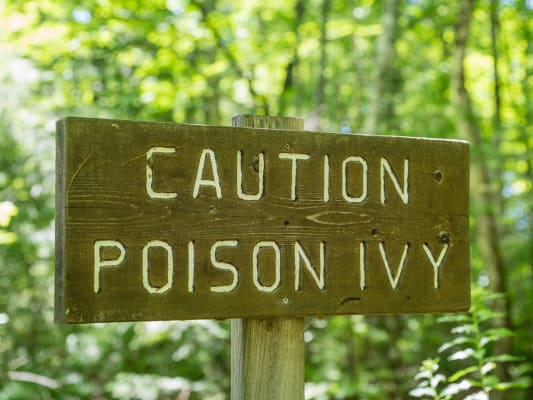Contact Dermatitis Due to Poison Ivy: A Risk of Golfing

Golf courses are often meticulously manicured, but what happens if you hit your ball too far to the right — toward the trees and rough? What are the risks?
In addition to potentially losing your ball, there could be health risks as a result of your shot — ones that make you itch! You could get bitten by mosquitos. (Consider wearing bug spray when golfing.) You could also get contact dermatitis.
Contact dermatitis can be caused by an allergic reaction to oily resin in some leaves, stems and roots of poison ivy, poison oak or poison sumac. It can be very itchy, and it could last for several weeks.
The signs of contact dermatitis due to poison ivy can include:
- Redness
- Itching
- Swelling
- Blisters
If you brush up against a plant, the rash will often appear in a straight line. However, if you touch something with the oily resin on it and then develop a rash, your rash may spread over more of your body. Contact dermatitis due to poison ivy may take 12 to 48 hours to develop after your exposure, and its severity depends on how much oil you get on your skin.
“Although it’s rare, it’s possible to get a severe reaction that causes trouble breathing when you are exposed to poison ivy, poison oak or poison sumac. This can especially occur if you inhale smoke from burning poisonous plants,” says Dr. Jenny Borovinskaya, of Middlesex Health Primary Care - Middletown. “If this happens, you should call 911 or visit your local emergency department immediately.”
What to do
If you know you’ve encountered poison ivy, poison oak or poison sumac, the first — and best — thing to do is to wash your skin (and your clothes and other items) immediately. This may reduce your chances of getting contact dermatitis.
Lotions and cool baths can help treat a mild case of contact dermatitis due to poison ivy, but you may need to see your primary care provider, or visit an urgent care center or emergency department, to get a prescription medication if your rash is severe or widespread, especially if the rash is on your face or genitals. You should also see a medical provider if you develop a high fever or if your blisters are oozing pus.
Prevention
To help prevent contact dermatitis due to poison ivy on the golf course, consider wearing protective clothing, such as pants. It’s also helpful to know what poison ivy, poison oak and poison sumac plants look like so that you can try to avoid them whenever possible.
A leaf on a poison ivy plant has three leaflets, and these plants grow as shrubs or a vine. A poison ivy vine has hair and looks like a rope. Poison oak plants have leaves that also have three leaflets, but these leaves have rounded tips, and they can be fuzzy underneath and lighter in color on top, while poison sumac plant leaves have clusters of seven to 13 leaflets each that are arranged in pairs. Poison sumac thrives in wet, swampy areas.
For more information
For more information about Middlesex Health Primary Care, click here. For information about Middlesex Health’s urgent care locations in Middletown and Old Saybrook, click here, and to learn more about Middlesex Health’s Emergency Department, click here.
Featured Provider

Jenny Borovinskaya, DO
Specialties / Areas of Care
- Family Medicine
- Pediatrics
Locations
- Middletown, CT
860-358-3130
- View Full Profile
- Accepting New Patients
More Stories
Making a Difference One Golf Swing at a Time
June was a busy month for Middlesex Health. In addition to providing excellent care every day for patients, celebrating Pride Month and marking Juneteenth, the health system was at the golf course supporting the community!
Spotlight: Men’s Health
When it comes to health care concerns that disproportionately impact men, such as heart disease and cancer, there is good news despite the grim statistics. With the help of a health care provider, many diseases are preventable.